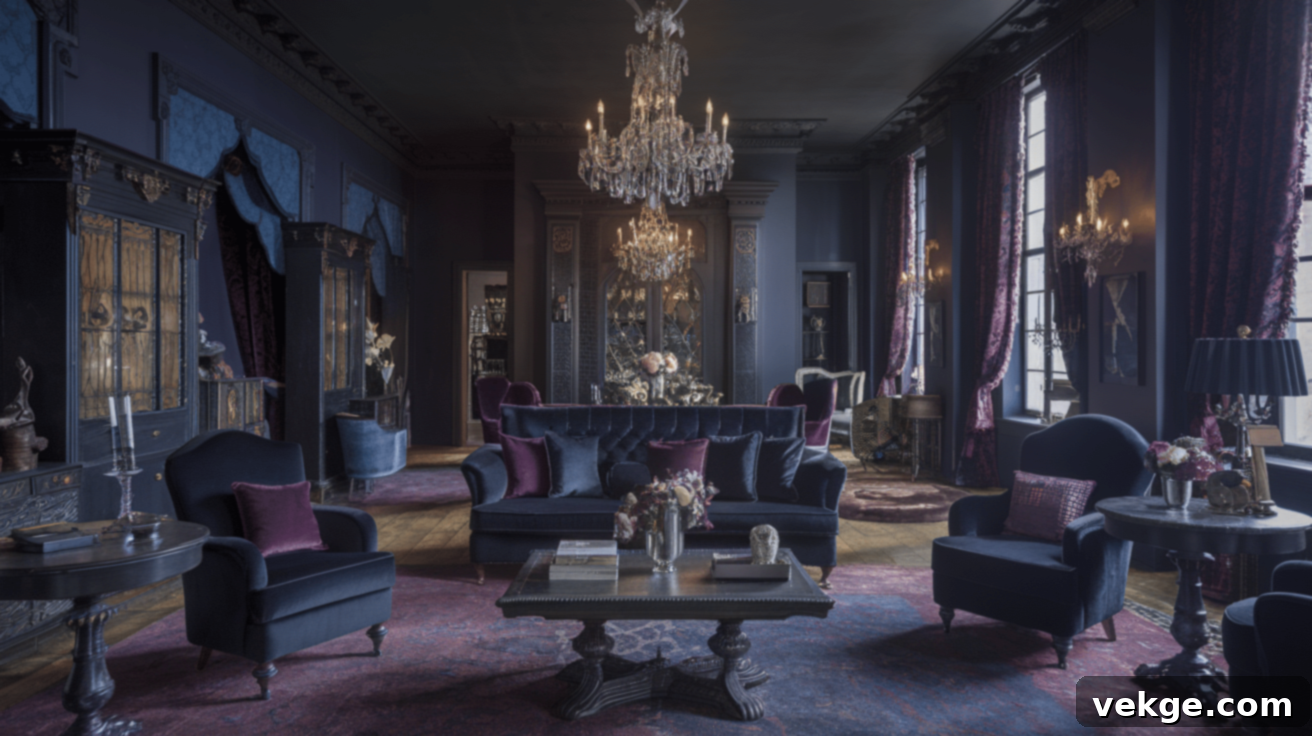Transform Your Home: A Guide to Modern Gothic Victorian Interior Design
Are you drawn to spaces that tell a story, exuding an air of mystery and sophisticated drama? If you’re looking to move beyond conventional bright and minimalist interiors, the Modern Gothic Victorian style might be your perfect match. Straight from the most inspiring Pinterest boards to the forefront of interior trends, this captivating aesthetic effortlessly combines the intricate elegance of Victorian eras with the bold, brooding allure of Gothic design. It’s a style that embraces dark beauty, rich textures, and a strong character, promising a truly unique atmosphere for your home.
This distinct fusion is rapidly gaining popularity among homeowners who crave an interior that stands out, offering a deep sense of history and modern comfort. In this comprehensive guide, we’ll dive deep into the Modern Gothic Victorian style, showing you how to incorporate its striking elements into your living space. From essential furniture pieces and a captivating color palette to the perfect lighting and textures, we’ll provide actionable tips that won’t just transform your home but will also respect your budget. Get ready to explore a world where the past meets the present in an utterly enchanting way.
What is Modern Gothic Victorian Interior Design?
Modern Gothic Victorian interior design is a sophisticated blend that takes the grandeur and intricate details of Victorian aesthetics and infuses them with the dramatic, often darker, elements of Gothic architecture and decor, all while incorporating contemporary sensibilities. Unlike its traditional counterparts, this modern interpretation avoids feeling heavy or overtly antiquated. Instead, it creates spaces that are both striking and inviting, rich in character yet perfectly suited for today’s living.
At its core, this style is defined by a bold and deep color palette, favoring shades like charcoal gray, deep emerald green, sapphire blue, royal purple, and, of course, classic black. These rich hues set the stage for a dramatic backdrop, which is then layered with ornate, vintage-inspired furnishings and intricate patterns. The key to its appeal lies in its ability to balance the old with the new, ensuring that homes feel both historically resonant and comfortably contemporary.
The Defining Characteristics of Modern Gothic Victorian Design Include:
- Rich, Dark Wall Colors: Think deep jewel tones or sophisticated charcoal, creating an immediate sense of depth and drama.
- Ornate Furniture with a Modern Twist: Pieces that echo Victorian craftsmanship but are perhaps streamlined or paired with modern elements.
- Detailed Woodwork and Architectural Embellishments: Crown molding, wainscoting, and decorative trim add a touch of historic elegance.
- Bold Patterns and Motifs: Often featuring damask, floral, or even nature-inspired themes like ravens and skulls, integrated subtly.
- Luxurious Heavy Fabrics: Velvet, silk, brocade, and damask contribute to the tactile richness and comfort.
- Statement Lighting Fixtures: Chandeliers, elaborate sconces, and unique lamps that cast interesting shadows and create ambiance.
- Thoughtful Integration of Natural Light: Unlike purely traditional Gothic, the modern version often uses natural light to highlight dark elements, preventing rooms from feeling gloomy.
What truly distinguishes Modern Gothic Victorian from a purely traditional Gothic style is its embrace of comfort and functionality. While traditional Gothic interiors can sometimes feel overly dark, formal, or museum-like, the modern iteration maintains the drama and aesthetic appeal without sacrificing livability. It achieves this by carefully integrating contemporary materials, open layouts, and a curated approach to decor, ensuring that each space feels lived-in, stylish, and deeply personal. It’s about creating a moody, romantic, and sophisticated environment that still offers all the conveniences of modern life.
Key Elements of Modern Gothic Victorian Interior Design
To truly capture the essence of Modern Gothic Victorian style, it’s essential to understand its foundational elements. Each component plays a crucial role in building the layered, dramatic, and sophisticated atmosphere characteristic of this unique aesthetic.
Furniture: Pieces with Presence and History
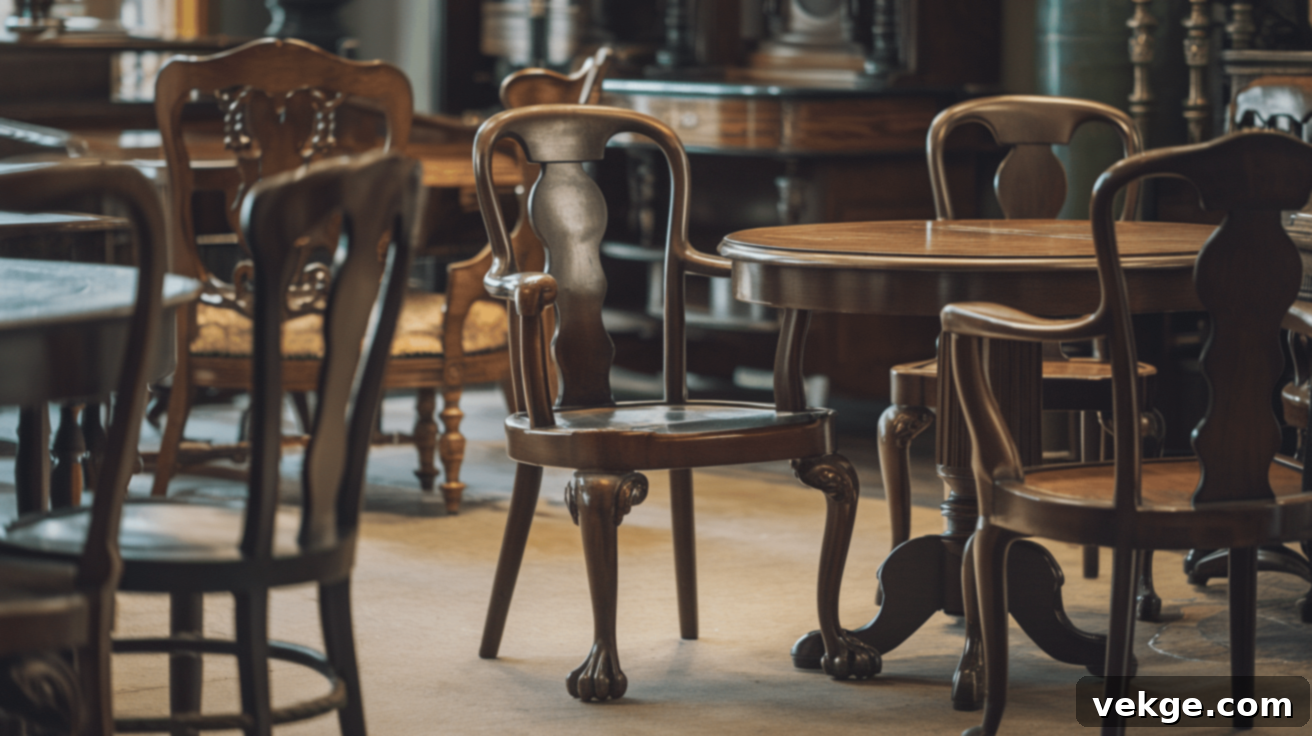
The furniture in a Modern Gothic Victorian home is often the cornerstone of its character. Look for pieces that possess a sense of history, intricate detailing, and substantial presence. Dark woods like mahogany, walnut, or ebony are ideal, instantly conveying the right mood. Seek out elegant settees with tufted upholstery, chairs featuring gracefully curved backs and ornate carvings, and tables with distinctive elements such as claw feet or carved pedestals. Cabinets with glass doors or intricate fretwork can display treasured curiosities, adding to the room’s narrative.
To modernize these pieces, consider pairing them with sleeker, contemporary items or choosing pieces that have been refinished in a matte black or deep jewel tone. Incorporating smaller, antique-inspired decorative items like vintage clocks, ornate mirrors, detailed candelabras, and antique book stands can effectively tie the aesthetic together without requiring a complete overhaul of your existing furnishings. These accessories layer in depth and personality, reinforcing the style’s rich narrative.
Color Palette: Deep, Dramatic, and Diverse
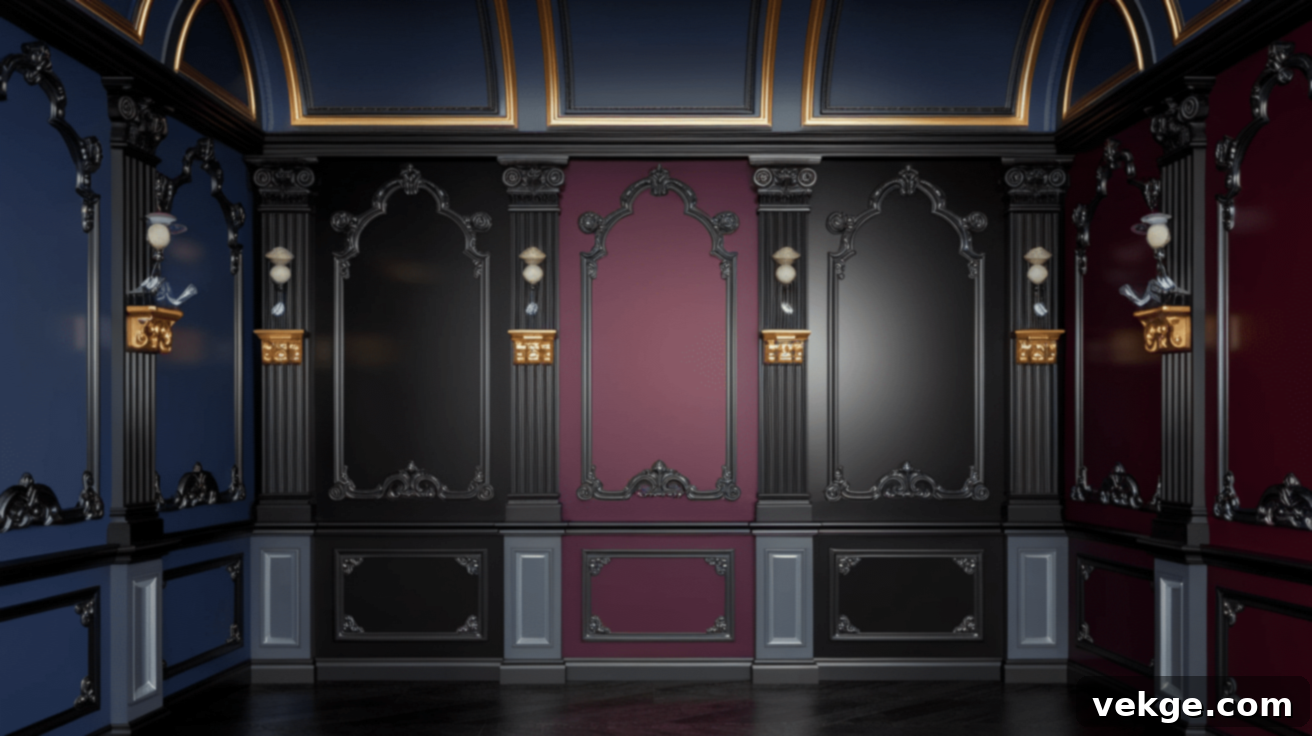
The color palette is arguably the most defining characteristic of Modern Gothic Victorian rooms, setting a profoundly dramatic and sophisticated tone. Move away from light and airy and embrace deep, rich shades that evoke mystery and luxury. Consider painting walls in striking dark blues, enigmatic blacks, luxurious purples, or passionate rich reds. For a less overwhelming but equally impactful statement, an accent wall in one of these bold hues can transform a room. These deep foundational colors serve as a perfect canvas for metallic accents, with gold or silver adding necessary contrast and opulence. Don’t shy away from incorporating secondary colors like deep forest greens, burnt oranges, or even dark grays to add complexity and interest to your scheme.
To prevent the space from feeling too heavy, strategically introduce elements of lighter, subdued colors through artwork, lighter-toned accessories, or even a strategic piece of furniture in a muted tone. This interplay between dark and light creates visual tension and prevents the room from becoming monotonous.
Textures: A Symphony of Sensory Richness
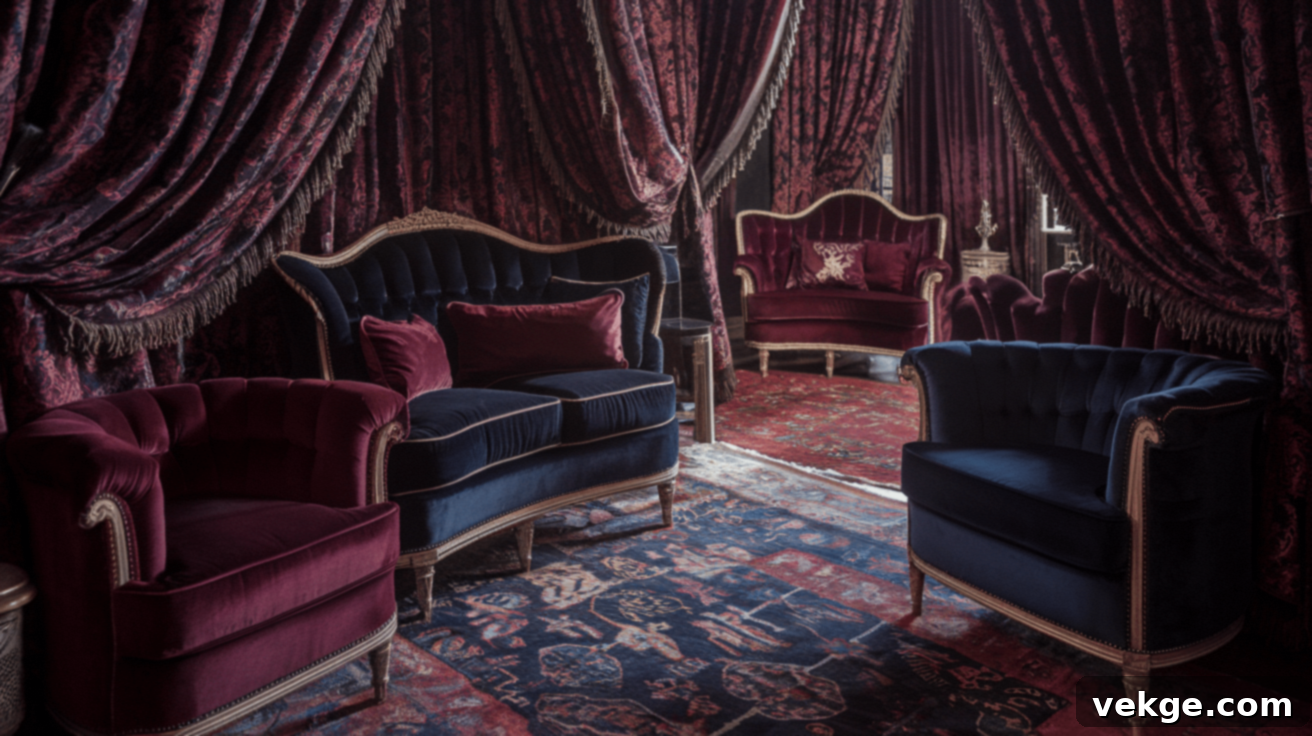
In Modern Gothic Victorian design, the tactile experience is just as crucial as the visual. Rich fabrics and varied textures contribute significantly to the warmth, depth, and luxurious feel of the space. Embrace materials that are sumptuous to the touch and visually engaging:
- Velvet: Plush velvet chairs, sofas, and throw pillows instantly add a layer of opulence, comfort, and a touch of vintage glamour. Its ability to catch light subtly enhances the drama.
- Silk and Damask: Heavy silk or damask curtains, drapes, or even upholstered panels create a sense of refined elegance, their sheen playing beautifully with different light sources.
- Wool and Faux Fur: Thick, patterned wool rugs or faux fur throws bring warmth, comfort, and an inviting softness underfoot, balancing the formality of other elements.
- Lace and Brocade: These delicate or richly woven fabrics can be introduced through table runners, cushion detailing, or decorative accents to add intricate patterns and delicate contrast.
Layering these textures is key to creating a cohesive and inviting atmosphere. A velvet sofa might be adorned with a silk throw, set atop a patterned wool rug. This interplay of different materials adds depth and sensory appeal, preventing the dark colors from feeling flat and ensuring the room feels luxurious and comfortable.
Architectural Features: Elegant Foundations
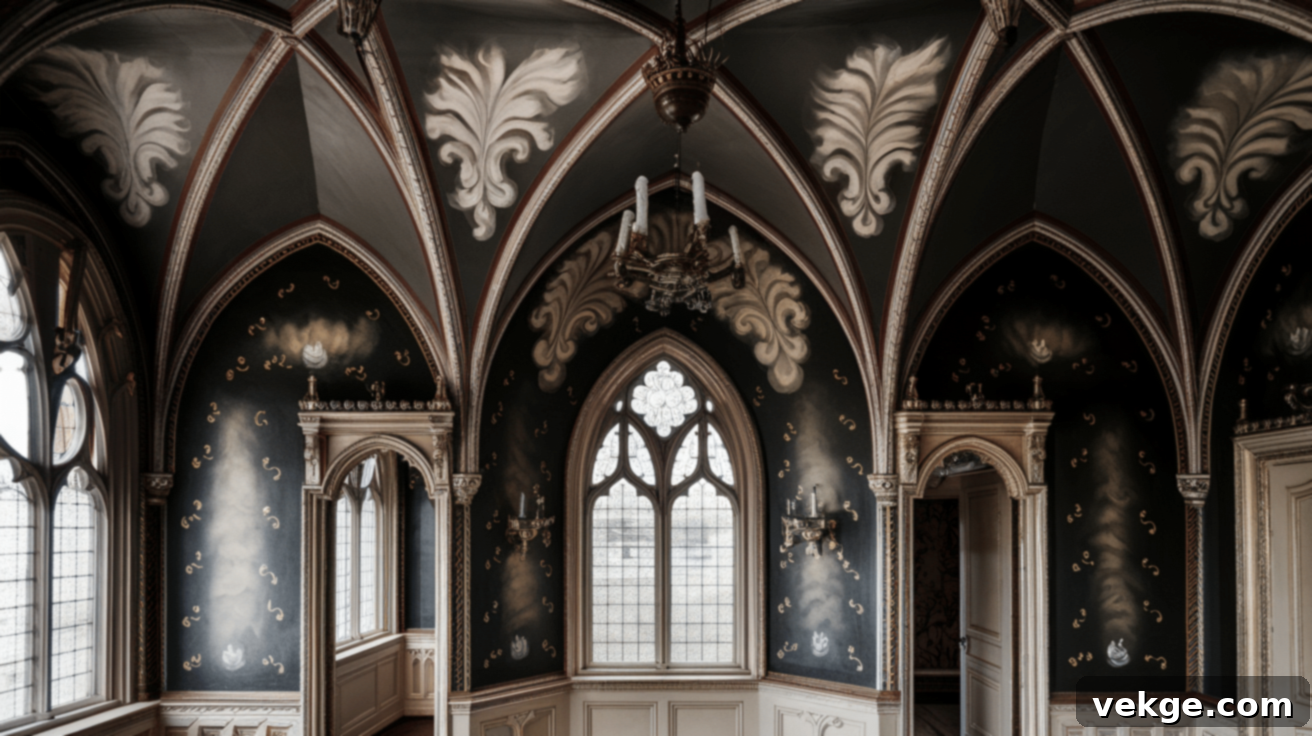
The inherent architectural elements of a room can profoundly enhance or establish the Gothic Victorian aesthetic. Look for features that boast pointed arches in doorways or windows, reminiscent of classic Gothic cathedrals. If your home has plain walls, consider adding decorative trim, crown molding, or wainscoting with detailed patterns to introduce that sense of historical elegance. These elements don’t just add visual interest; they provide a framework that elevates the entire design.
For those looking to make a grand statement, hand-painted walls or elaborate wallpaper featuring nature patterns, romantic scenes, or classic damask can become the central focal point of a room. If structural changes aren’t feasible, you can still infuse these touches. Choose furniture or art pieces with similar arched shapes, intricate carvings, or detailed patterns. Even a large, ornate mirror can mimic the grandeur of a Gothic window, drawing the eye and adding architectural interest where none existed before.
Steps to Design Your Home in Modern Gothic Victorian Style
Embarking on a design project can seem daunting, but by following a structured approach, you can transform your space into a captivating Modern Gothic Victorian sanctuary. Here’s a step-by-step guide to help you achieve this unique look.
1. Start with a Neutral (Yet Dark) Base
The foundation of any successful Modern Gothic Victorian interior lies in its base colors. Begin by setting a dramatic stage with walls painted in deep, sophisticated neutral colors. Charcoal gray, deep navy, rich forest green, or even a bold matte black are excellent choices. These colors absorb light, creating a sense of intimacy and depth. For flooring, dark wood planks, black tiles, or even deep-stained concrete can provide the perfect moody backdrop. If changing your existing flooring isn isn’t an option, a large, dark-colored area rug with subtle, traditional patterns can anchor the room and define the aesthetic.
Consider the natural light in your room when choosing how dark to go. Rooms with ample natural light can handle darker wall colors more easily without feeling oppressive. For rooms with less light, balance dark walls with lighter ceiling colors or reflective metallic accents.
2. Incorporating Key Design Elements
Once your base is established, it’s time to layer in the quintessential elements that define the Modern Gothic Victorian style. These pieces will bring the drama, elegance, and character to your space:
- Statement Seating: Invest in a lavish sofa or a pair of armchairs upholstered in luxurious velvet or supple leather. Choose pieces with classic silhouettes, tufting, or carved wooden details.
- Ornate Wooden Furniture: Add dark wood pieces like a grand bookcase, an antique chest, or a console table with carved legs. These provide visual weight and a touch of historical authenticity.
- Dramatic Lighting: Install a central black iron or brass chandelier with crystal drops, or opt for wall sconces designed to resemble old candle holders. These aren’t just light sources; they are sculptural art pieces.
- Heavy, Opulent Curtains: Dress your windows with floor-length curtains in dark, rich colors or fabrics with elaborate damask or floral patterns. These add to the room’s luxurious feel and control light beautifully.
- Unique Artwork and Mirrors: Display art with dark, moody themes or vintage portraits in ornate, gilded frames. Large, decorative mirrors can also expand the space and reflect light, preventing it from feeling too dark.
3. Tips on Blending Modern and Vintage Items
The “modern” aspect of this style comes from a thoughtful blend of old and new. This fusion keeps the look fresh and prevents it from feeling like a period museum. The trick is to find common ground in color, texture, or form:
- Contrast and Complement: Pair an antique dark wood dining table with sleek, modern chairs in a complementary dark fabric.
- Functional Integration: Place contemporary electronics (like a flat-screen TV) on a beautifully carved antique console or within a vintage cabinet.
- Artful Juxtaposition: Display modern abstract art in ornate, traditional frames, or hang vintage botanical prints in simple, contemporary frames.
- Fabric Harmony: Use modern fabrics with classic patterns, or choose contemporary furniture pieces upholstered in luxurious Victorian-era textiles like velvet or brocade.
- Accessory Blend: Mix vintage curiosities with minimalist modern decorative objects on a bookshelf or mantelpiece.
The key is to maintain a consistent dark, rich color palette throughout the blend, which naturally ties disparate items together into a cohesive aesthetic.
4. Furniture and Decor Suggestions: Where to Find Your Treasures
Sourcing the right pieces is an exciting part of creating your Modern Gothic Victorian home. Look in a variety of places to find unique items that speak to you.
Where to find items:
- Local Thrift Stores and Estate Sales: These are goldmines for true vintage pieces, from furniture to small decorative objects, often at incredibly affordable prices. Look for dark wood, ornate details, and unique finds.
- Antique Markets and Fairs: For one-of-a-kind, authentic antique finds, visit larger markets. Be prepared to haggle and inspect items for quality.
- Online Marketplaces: Websites like Etsy, eBay, and even Facebook Marketplace offer a vast selection of both vintage and newly crafted Gothic-inspired items. Many artisans create bespoke pieces perfect for this style.
- Modern Furniture Stores with Victorian-Inspired Collections: Many contemporary brands now offer pieces that incorporate Victorian elements, such as tufted velvet sofas, dark wood tables with carved details, or ornate lighting.
5. Affordable vs. High-End Options
Achieving the Modern Gothic Victorian look doesn’t require an unlimited budget. You can mix and match to create an opulent feel at any price point.
Budget-friendly ideas:
- DIY Furniture Transformation: Paint existing furniture pieces (dressers, side tables, chairs) in matte black, deep navy, or rich burgundy. Replace hardware with ornate, Gothic-style pulls.
- Accent Wall Wallpaper: Instead of wallpapering an entire room, choose one accent wall for a dramatic, patterned wallpaper.
- Second-Hand Fabrics: Hunt for velvet curtains or heavy brocade fabrics at thrift stores or fabric remnants sales. Even old velvet dresses can be repurposed into throw pillow covers.
- Frame It Up: Purchase inexpensive Gothic-style picture frames and fill them with your own photos, dark botanical prints, or even digital art found online.
- Candlelight and DIY Sconces: Utilize an abundance of candles in elegant holders, and consider making simple wall sconces from repurposed materials.
Worth the splurge:
- A Quality Velvet Sofa: A well-made velvet sofa is an investment piece that offers comfort, durability, and instantly elevates the room’s luxurious feel.
- One Real Antique Statement Piece: A truly exceptional antique, such as a grand carved bookcase, a unique curio cabinet, or a vintage fireplace mantel, can be the focal point of your design.
- Custom-Made Gothic Headboard: A bespoke headboard, perhaps upholstered in velvet with tufting or carved dark wood, will transform your bedroom into a dramatic retreat.
- High-Quality Area Rug: A beautifully patterned, thick area rug in a Victorian motif can anchor a room, add warmth, and introduce sophisticated color and texture.
- Artisanal Lighting Fixtures: A unique chandelier or custom-designed sconces can cast incredible shadows and create an unparalleled ambiance.
Practical Design Tips for Your Modern Gothic Victorian Home
Beyond selecting the right elements, understanding how to apply them is crucial. These practical tips will help you fine-tune your Modern Gothic Victorian interior to perfection.
Lighting Choices for a Gothic Ambiance
Lighting is paramount in setting the mood for Gothic Victorian style. The goal is to create a warm, inviting glow that emphasizes shadows and highlights textures, rather than relying on harsh, bright illumination. Layered lighting is key to achieving depth and dimension.
Best lighting options:
- Dramatic Chandeliers: Opt for black wrought iron, antique brass, or crystal-laden chandeliers as central fixtures. These should be statement pieces that cast intricate patterns of light and shadow.
- Wall Sconces: Install sconces that mimic old candle holders or gas lamps, positioned at eye level to provide ambient light and highlight architectural features.
- Table and Floor Lamps: Choose lamps with dark fabric shades (velvet, silk) or stained-glass panels that diffuse light softly. Ornate bases in dark metals or carved wood enhance the aesthetic.
- Hidden Lighting: Use LED strip lights or string lights discreetly placed behind furniture, along crown molding, or within display cabinets to create a soft, ethereal glow.
- Candles: An abundance of candles, housed in elaborate candelabras or simple dark holders, adds an incomparable romantic and mysterious atmosphere.
The trick is to have multiple light sources at varying heights (overhead, mid-level, and low-level) rather than relying on a single bright overhead light. This layering creates depth, allows for mood adjustments, and prevents the room from feeling flat or too dim. Installing dimmers on all light fixtures gives you complete control over the ambiance, letting you shift from a brighter, functional light to a soft, intimate glow with ease.
Choosing the Right Fabrics for Upholstery and Curtains
Fabrics are essential for adding richness, warmth, and tactile luxury to Modern Gothic Victorian rooms. They should feel as exquisite as they look, contributing to the overall sensory experience of the space.
Best fabric choices:
- Velvet: Ideal for sofas, armchairs, and throw pillows. Its deep pile, rich colors, and ability to reflect light make it incredibly luxurious and durable.
- Heavy Silk or Damask: Perfect for curtains, drapes, and even accent upholstery. These fabrics offer a beautiful sheen and often come with intricate traditional patterns.
- Brocade: A richly woven fabric with raised patterns, brocade adds an elaborate, historical feel to cushions, upholstery, or even wall coverings.
- Wool: Excellent for rugs and throws, wool provides natural warmth, texture, and durability. Look for deep-toned or patterned wool rugs.
- Leather: For a more rugged yet sophisticated touch, dark leather on a statement chair or a chesterfield sofa can introduce a masculine edge that complements the Gothic aesthetic.
- Lace: Use lace sparingly for delicate accents like table runners, trim on curtains, or pillow details, adding a touch of fragile beauty.
While dark, deep colors are predominant, don’t shy away from subtle patterns. Look for fabrics that feature small skulls, ravens, intertwined botanicals, or classic geometric designs. These patterns add visual interest and narrative without making the space feel overly busy. Layering different fabric types – a velvet sofa with silk cushions and a wool throw – creates a luxurious, multi-dimensional texture profile that is key to this style.
Mixing Contemporary Furniture with Vintage Finds
The brilliance of Modern Gothic Victorian lies in its ability to seamlessly blend the past with the present. This prevents the space from feeling like a static museum and ensures it remains functional and comfortable for modern living.
Tips for mixing styles effectively:
- Color as a Unifier: Maintain a consistent dark, rich color palette across both modern and vintage pieces. If everything shares a similar tone, they will naturally look like they belong together.
- Echo Shapes and Lines: Choose modern furniture pieces that have subtle design elements (like curves, straight lines, or general proportions) that echo your vintage finds. This creates visual harmony.
- Functional Contrast: Pair a sleek, minimalist modern desk with an ornate antique desk chair. The contrast highlights the beauty of both pieces.
- Modern Art in Classic Frames: Hang contemporary abstract art in elaborately carved, gilded, or dark antique frames. This juxtaposition is visually exciting.
- Vintage Accessories with Modern Pieces: Adorn a modern, clean-lined console table with a collection of antique curiosities, vintage clocks, or ornate mirrors.
- Strategic Material Mix: Blend new black metal shelving units with aged wooden antique cabinets. The different textures and finishes add depth.
A balanced room often strikes a ratio, perhaps 60-70% modern pieces (for comfort, functionality, and ease of acquisition) to 30-40% vintage items (for character, history, and unique flair). The goal is to create a thoughtful dialogue between different eras, ensuring each piece feels purposeful and contributes to a cohesive, intriguing narrative within your home.
Common Mistakes to Avoid in Modern Gothic Victorian Design
While creating a Modern Gothic Victorian interior offers immense creative freedom, certain pitfalls can detract from the desired aesthetic. Being aware of these common mistakes can help you maintain balance, elegance, and functionality in your design.
Overusing Dark Colors
Dark colors are undeniably the backbone of the Gothic Victorian style, but an excessive reliance on them without proper balance can lead to a space that feels oppressive, gloomy, and visually heavy, rather than dramatic and sophisticated.
How to fix this mistake:
- Introduce Metallics: Integrate reflective metallic elements such as gold or silver mirrors, brass fixtures, or bronze sculptures. These elements bounce light around the room, adding sparkle and breaking up the darkness.
- Add Lighter Accents: Introduce strategic touches of lighter, contrasting colors like cream, deep ivory, or even muted grays through throw pillows, smaller decorative objects, or patterned textiles.
- Vary Shades: Instead of uniformly dark walls and furniture, use different shades within the dark color family (e.g., deep blue-black walls with a dark emerald green sofa) to create subtle variations and depth.
- Lighter Ceilings: Consider painting ceilings a lighter, perhaps slightly off-white or very light gray color, especially in rooms with lower ceilings, to create a sense of height and openness.
- Incorporate Greenery: Living plants with lush, bright green foliage not only add a touch of life and freshness but also provide a natural color contrast against dark backdrops.
The key is balance. For every dark wall or substantial piece of furniture, try to introduce something that reflects light, adds a lighter hue, or provides a vibrant splash of natural color. This interplay keeps the room dynamic and prevents it from feeling like a cave.
Clashing Modern and Vintage Pieces
The art of blending contemporary and antique items is central to Modern Gothic Victorian design, but without thoughtful curation, the mix can appear haphazard and chaotic rather than harmoniously eclectic.
How to fix this mistake:
- Consistent Color Theme: Ensure that both your old and new items adhere to a consistent overall color scheme. Even if styles differ, shared colors will unify them.
- Complementary Forms: Choose modern pieces with shapes or lines that subtly echo your vintage finds. For example, pair a traditional curved armchair with a modern sofa that has a gentle, inviting curve rather than harsh angles.
- Strategic Grouping: Group similar items together, rather than scattering them randomly. A vignette of vintage curios on a modern shelf, for instance, looks more intentional than isolated pieces.
- Purposeful Placement: Every piece, whether old or new, should serve a purpose, either functional or aesthetic. Avoid cluttering with items that don’t contribute to the overall design.
- Shared Textures or Materials: Use unifying elements like the same luxurious velvet on both a vintage-inspired armchair and a contemporary throw pillow, or integrate dark wood across different eras of furniture.
Before purchasing new items, ask yourself if they share at least one quality (color, material, shape, or theme) with your existing vintage pieces. This creates a curated, thoughtful blend rather than a confusing jumble, demonstrating a sophisticated understanding of design harmony.
Ignoring Balance and Space
Given the ornate and often substantial nature of Gothic Victorian elements, there’s a risk of overcrowding a room, making it feel cramped, uninviting, and difficult to navigate. A truly successful design prioritizes both aesthetics and functionality.
How to fix this mistake:
- Embrace Negative Space: Leave some wall space empty between hanging artwork or mirrors. This allows the eye to rest and makes the pieces that are displayed stand out more.
- Ensure Clear Pathways: Arrange furniture to allow for easy and comfortable movement throughout the room. Avoid blocking doorways or creating awkward traffic flows.
- Contain Small Items: Group smaller decorative items on trays, in display cabinets, or within defined areas, rather than spreading them haphazardly across all surfaces. This reduces visual clutter.
- Curate Statement Pieces: Instead of filling the room with many small, competing items, select a few truly impactful statement pieces that command attention and allow them room to breathe.
- Consider Room Proportions: Choose furniture and decor that are appropriately scaled to the size of your room. Oversized pieces in a small room will overwhelm it, while tiny pieces in a grand space will get lost.
Remember that your home is meant to be lived in, not just admired. Prioritize comfort, functionality, and an inviting atmosphere. Ensure natural light sources aren’t completely blocked by heavy curtains or tall furniture, allowing some light to penetrate. Thoughtfully placed plain areas amidst the detailed ones create visual breathing room, enhancing the impact of your special, ornate elements.
Conclusion
The Modern Gothic Victorian style offers a truly unique opportunity to infuse your home with dramatic character, rich history, and sophisticated allure. By artfully blending the intricate elegance of the Victorian era with the bold, often darker, aesthetics of Gothic design, you can create a space that feels both timeless and exceptionally contemporary. We’ve explored the foundational elements, from the power of deep color palettes and ornate furniture to the luxurious embrace of rich textures and the deliberate use of atmospheric lighting.
As you embark on your design journey, remember these key principles:
- Start with a Dark, Rich Base: Set the mood with deep wall colors and substantial flooring.
- Strategically Mix Old and New: Blend contemporary comfort with vintage charm to keep the style fresh and livable.
- Use Contrast Wisely: Balance dark elements with metallics, lighter accents, and living greenery to prevent spaces from feeling gloomy.
- Prioritize Balance and Functionality: Ensure clear pathways, thoughtful arrangements, and a sense of openness, even amidst rich detailing.
- Choose Quality Materials: Invest in luxurious fabrics and well-crafted furniture that contribute to the tactile and visual richness of the style.
- Layer Your Lighting: Utilize multiple light sources at varying heights to create depth, dimension, and adjustable ambiance.
Ultimately, the most successful Modern Gothic Victorian interiors are those that reflect the personality and story of their inhabitants. Don’t be afraid to add personal touches, unique curiosities, and items that genuinely resonate with you. Feel empowered to break some traditional rules if it means creating a space that feels authentic and inspiring.
What Modern Gothic Victorian touches have you incorporated into your own home? Share your unique ideas, cherished finds, and design inspirations in the comments below – we’d love to hear about and see what captivating spaces you’ve brought to life!
